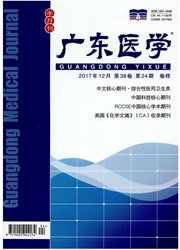

 中文摘要:
中文摘要:
目的 观察我国艾滋病患者(AIDS)启动高效抗反转录病毒治疗(HAART)后,发生免疫重建炎性综合征(IRIS)的发病率、病死率、临床特征及其好发易感影响因素.方法 以2007年10月到2009年9月来自湖南省和江四省的接受HAART治疗的238例AIDS患者建立前瞻性研究队列,在24周内进行定期随访.将此期间发生IRIS的47例患者纳入IRIS组,24周时仍未发生IRIS的191例患者纳入非IRIS组.收集两组患者的一般资料、临床发病表现和诊断治疗的相关资料,在HAART的0、12和24周采集患者的血标本检测HIV病毒载量和CD4+细胞计数,对所有资料进行统计学处理和对比分析.结果 IRIS发生率为19.7%(47/238),病死率6.2%(2/47) HAART起动后发生IRIS的平均天数为28(9~36)d.IRIS中以结核感染占多数(61.7%,29/47),IRIS组与非IRIS组在年龄、性别、传播途径以及抗病毒治疗的方案上差异均无统计学意义.在0、12和24周时两组的病毒载量均逐步明显下降,CD4+细胞数均逐步明显上升.但是启动HAART时IRIS组的CD4+细胞数明显低于非IRIS组(48×106个/L比146×106个/L,P<0.01),IRIS组的CD4+细胞数在100×106个/L以内者占85.1%(40/47).结论 IRIS多发生在HAART治疗启动后的1~3个月内,接受HAART治疗者的年龄、性别、传播途径以及抗病毒治疗的方案均与IRIS的发生无明显相关.在治疗24周内IRIS组与非IRIS组的HIV RNA病毒载量下降幅度和CD4细胞上升数量均无明显差别,但起动HAART前CD4+细胞计数<100 × 106个/L的感染者更容易出现IRIS.我国HAART发生IRIS多为结核感染,一般无须停用抗病毒药物,对症处理即可,但对结核病或其他严重的感染仍须抗感染治疗.
 英文摘要:
英文摘要:
Objective To summarize the morbidity, mortality, clinical manifestations and risk factors for IRIS (immune reconstruction inflammatory syndrome) during HAART (highly active antiretroviral therapy) in China. Methods From October 2007 to September 2009, a prospective cohort of 238 AIDS (acquired immunodeficiency syndrome) patients on HAART from Hunan and Jianxi provinces was recruited for a follow-up of 24 weeks. And 47 and 191 patients were assigned into the IRIS and non-IRIS groups respectively. The data of general information, clinical manifestations and treatment of two groups were collected and compared. Blood samples were collected in both groups at pre-and post-HAART 12 weeks, 24weeks for HIV viral load and CD4 + cell count examinations. A statistical analysis was performed. Results A total of 47 ( 19. 7% ) IRIS cases was analyzed. The median onset of IRIS was 28 (9 -36) days. And 29(61.7%) cases of tuberculosis IRIS were found. There was no significant difference in age, gender, route of transmission and antiretroviral regimens between the IRIS and non-IRIS groups. At baseline, Weeks 12 and 24, both groups showed a significant decline of viral load. And there was no significant difference between them. Both groups showed a significant increase of CD4 + cell count. But there was no significant difference between two groups. However, the baseline CD4+ cell count was markedly lower in the IRIS group than that in the non-IRIS group. In 85. 1% (40/47)of cases, the CD4+ cell count was 〈 100 × 106/L in the IRIS group at the baseline of HAART. Conclusion IRIS mostly occurs during 3 months of HAART initiation.The age, gender, route of transmission and antiretroviral treatment regimens of patients on HAART are not risk factors for the development of IRIS. The HIV RNA viral load decreases in both IRIS and non-IRIS groups without any significant difference. The patients with a CD4 + cell count 〈 100/μl are more vulnerable to develop IRIS.
 同期刊论文项目
同期刊论文项目
 同项目期刊论文
同项目期刊论文
 期刊信息
期刊信息
